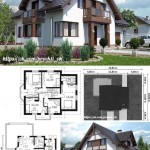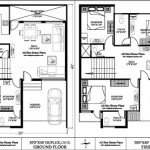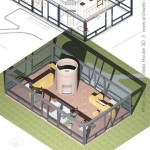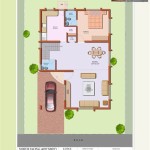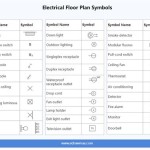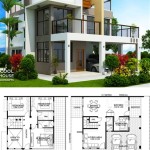Modern House Plans With Basement Garage: Functionality Meets Design
The integration of a basement garage into modern house plans presents a unique solution for homeowners seeking to maximize space and enhance property value. This architectural approach blends structural practicality with contemporary aesthetics, offering a seamless connection between the interior living spaces and the convenience of secure, accessible parking. Modern house plans incorporating basement garages are gaining popularity due to their ability to address various site-specific challenges and lifestyle preferences.
One of the primary drivers behind this trend is the increasing demand for efficient land use. In urban areas or on properties with challenging topography, building a detached garage can be impractical or even impossible. A basement garage eliminates the need for additional surface-level structures, preserving valuable outdoor space and maintaining a clean, uncluttered aesthetic. Furthermore, the design allows for direct access to the home, providing convenience and security, especially in inclement weather.
The design considerations for modern house plans with basement garages are multifaceted. Structural integrity, drainage systems, and ventilation are crucial aspects that must be carefully addressed during the planning and construction phases. Architects and engineers collaborate to ensure that the design not only meets building codes but also optimizes the functionality and safety of the garage space. The integration of natural light, efficient lighting systems, and durable finishes further enhances the overall appeal and usability of the basement garage.
Aesthetically, modern house plans with basement garages often incorporate design elements that seamlessly blend the garage entrance with the overall architectural style of the home. This can be achieved through the use of complementary materials, subtle landscaping, and thoughtful placement of the garage door. The goal is to create a cohesive design that enhances the curb appeal of the property while minimizing the visual impact of the garage.
Maximizing Space and Efficiency
The core benefit of incorporating a basement garage into a modern house plan lies in its ability to maximize space utilization. By placing the garage underground, the design frees up valuable square footage on the main level of the home, allowing for more expansive living areas, larger yards, or additional landscaping features. This is particularly advantageous for smaller lots where maximizing every square foot is essential.
Furthermore, a basement garage can serve multiple purposes beyond vehicle storage. The space can be designed to accommodate a workshop, a home gym, or even additional storage for seasonal items. The flexibility of the space allows homeowners to customize the garage to meet their specific needs and lifestyle requirements.
Efficiency is another key advantage of this design approach. Direct access from the garage to the home eliminates the need to navigate outdoor elements when entering or exiting the vehicle. This is particularly beneficial during harsh weather conditions, such as rain, snow, or extreme temperatures. Additionally, the proximity of the garage to the home can simplify the process of transporting groceries, luggage, or other items.
From an energy efficiency perspective, a basement garage can contribute to the overall thermal performance of the home. The earth surrounding the garage acts as a natural insulator, helping to maintain a more consistent temperature within the space. This can reduce the need for supplemental heating or cooling, resulting in lower energy bills and a smaller carbon footprint.
Careful consideration must be given to the placement and design of the driveway leading to the basement garage. The slope of the driveway, the materials used, and the drainage system are all critical factors that can impact the functionality and safety of the garage. A well-designed driveway should provide easy access for vehicles of all sizes while minimizing the risk of water accumulation or ice formation.
Addressing Structural and Environmental Considerations
The construction of a basement garage requires careful attention to structural integrity and environmental factors. The design must account for soil conditions, groundwater levels, and local building codes to ensure the long-term stability and safety of the structure. Proper waterproofing and drainage systems are essential to prevent water damage and maintain a dry, usable space.
The foundation walls of the basement garage must be designed to withstand the lateral pressure of the surrounding soil. This typically involves the use of reinforced concrete or other durable materials that can resist cracking or deformation. The thickness of the foundation walls and the amount of reinforcement required will depend on the specific soil conditions and the depth of the basement.
Waterproofing is a critical aspect of basement garage construction. A comprehensive waterproofing system should include a combination of exterior membranes, internal drainage systems, and sump pumps to effectively manage groundwater. The goal is to create a barrier that prevents water from entering the garage, even in areas with high water tables or heavy rainfall.
Ventilation is another important consideration for basement garages. Adequate ventilation is necessary to remove exhaust fumes, prevent the buildup of moisture, and maintain air quality within the space. This can be achieved through the use of natural ventilation, mechanical ventilation systems, or a combination of both. The ventilation system should be designed to meet local building codes and ensure the safety and comfort of the occupants.
In areas prone to seismic activity, the design of the basement garage must incorporate seismic-resistant features to mitigate the risk of damage from earthquakes. This may involve the use of reinforced concrete, steel framing, and specialized connection details that can withstand seismic forces. A structural engineer should be consulted to ensure that the design meets the applicable seismic codes and standards.
Furthermore, the environmental impact of constructing a basement garage should be carefully considered. Measures should be taken to minimize soil erosion, protect water quality, and preserve natural habitats during the construction process. The use of sustainable building materials and energy-efficient technologies can further reduce the environmental footprint of the project.
Design Aesthetics and Home Value Enhancement
Beyond functionality and structural considerations, the aesthetic design of the garage plays a crucial role in enhancing the overall appeal and value of the home. Modern house plans with basement garages often incorporate design elements that seamlessly integrate the garage entrance with the architectural style of the home.
The selection of garage doors is a key factor in achieving a cohesive design. Modern garage doors are available in a wide range of materials, styles, and colors, allowing homeowners to choose options that complement the overall aesthetic of the home. Options such as glass panels, wood accents, and custom hardware can add a touch of sophistication and enhance the curb appeal of the property.
Landscaping can also be used to soften the visual impact of the garage entrance. Planting trees, shrubs, and flowers around the driveway and garage door can create a more inviting and natural appearance. The use of retaining walls or other landscaping features can also help to integrate the garage into the surrounding landscape.
Interior finishes and lighting play a critical role in transforming a basement garage from a utilitarian space into a functional and aesthetically pleasing area. The use of durable floor coatings, such as epoxy or polyurethane, can protect the concrete floor from damage and provide a clean, professional look. Adequate lighting is essential for safety and visibility, and can be achieved through the use of LED fixtures, recessed lighting, or track lighting systems.
The addition of a basement garage can significantly increase the value of a home. The convenience of direct access, the security of enclosed parking, and the added storage space are all features that appeal to potential buyers. In areas with limited parking or challenging topography, a basement garage can be a particularly valuable asset.
When planning a modern house with a basement garage, consider the integration of smart home technology. Automatic garage door openers that can be controlled via smartphone, security cameras, and remote lighting control can add convenience and peace of mind. Furthermore, electric vehicle charging stations can be installed to accommodate the growing demand for electric cars.

Hillside House Plans With Garages Underneath Houseplans Blog Com

4 Bedroom Contemporary Drive Under Style House Plan 4742

Floor Plan With Underground Garage Plans Of Houses Models And Facades

Drive Under House Plans With Basement Garage The Designers

Modern Style Single Y House With Underground Garage And Storage Area

This Is A Nice House Love The Underground Garage Idea Designs Exterior Facade Architecture

Hillside House Plans With Garages Underneath Houseplans Blog Com

Luxury Basements How Prestige Homes Are Taking High End Design To A Space You Didn T Expect

House Basement Garage Google Search Minimalist Design Plans Modern Exterior

Modern Style Single Y House With Underground Garage And Storage Area

